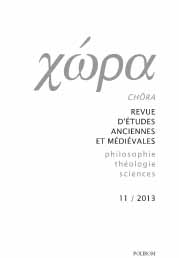SÉNÈQUE ET LE «THÉÂTRE» DE LA CAUSALITÉ, ENTRE NÉCESSITÉ ET CONTINGENCE
SÉNÈQUE ET LE «THÉÂTRE» DE LA CAUSALITÉ, ENTRE NÉCESSITÉ ET CONTINGENCE
Author(s): Cécile MerckelSubject(s): Philosophy
Published by: EDITURA POLIROM S.A.
Summary/Abstract: Generally in agreement with the stoic doctrin of causality, Seneca’s primary concern is not conceptual precision, but rather the way the problem of causality is perceived and understood by the human mind, which is unable to comprehend immediately the world’s absolute rationality. The relative vagueness surrounding the notion of cause, and particularly that of Primary Cause (which merges with the stoic god), implies the use of a pedagogical device which prepares the progrediens to grasp the ambiguity existing between necessity and contingency. Seneca dramatizes causality, creates a play, and provides the deus with masks (personae), so as to allow the progressing student of wisdom to comprehend the various facets of the god, as perceived by man, wise or not : necessity, contingency, Fortune, providence. The Roman philosopher’s favourite tools in this dramatization of causality are on one hand the personification of Fortune, and on the other the symbolical hypotyposis which allows the conceptualization of the Primary Cause, governing the world, through an analogy with a concrete figure, particularly that of the ideal princeps. So, through this theatrical depiction of causality, the philosopher provides the „spectator” with a distanciation, a catharsis and a comprehension of the world.
Journal: Chôra. Revue d'études anciennes et médiévales
- Issue Year: 2013
- Issue No: 11
- Page Range: 221-244
- Page Count: 24
- Language: French
- Content File-PDF

